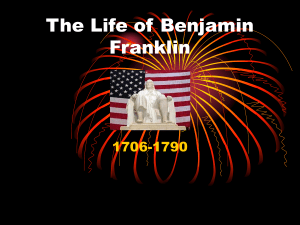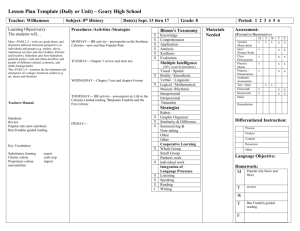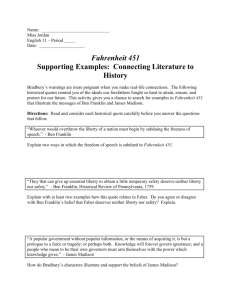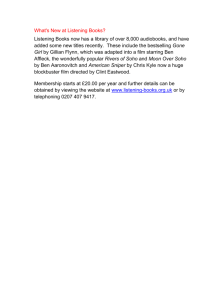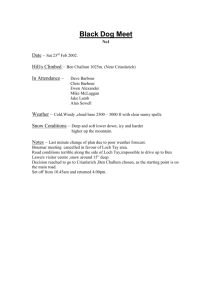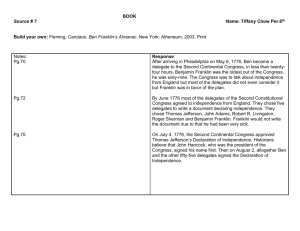Ben Franklin Opening Lesson
advertisement
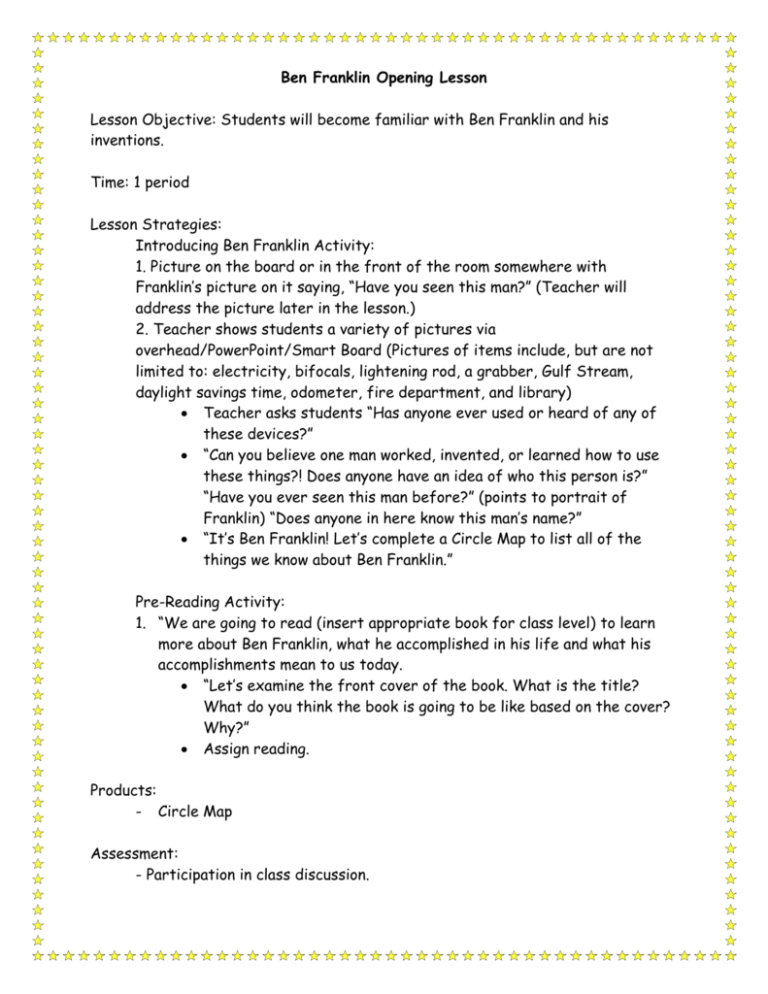
Ben Franklin Opening Lesson Lesson Objective: Students will become familiar with Ben Franklin and his inventions. Time: 1 period Lesson Strategies: Introducing Ben Franklin Activity: 1. Picture on the board or in the front of the room somewhere with Franklin’s picture on it saying, “Have you seen this man?” (Teacher will address the picture later in the lesson.) 2. Teacher shows students a variety of pictures via overhead/PowerPoint/Smart Board (Pictures of items include, but are not limited to: electricity, bifocals, lightening rod, a grabber, Gulf Stream, daylight savings time, odometer, fire department, and library) Teacher asks students “Has anyone ever used or heard of any of these devices?” “Can you believe one man worked, invented, or learned how to use these things?! Does anyone have an idea of who this person is?” “Have you ever seen this man before?” (points to portrait of Franklin) “Does anyone in here know this man’s name?” “It’s Ben Franklin! Let’s complete a Circle Map to list all of the things we know about Ben Franklin.” Pre-Reading Activity: 1. “We are going to read (insert appropriate book for class level) to learn more about Ben Franklin, what he accomplished in his life and what his accomplishments mean to us today. “Let’s examine the front cover of the book. What is the title? What do you think the book is going to be like based on the cover? Why?” Assign reading. Products: - Circle Map Assessment: - Participation in class discussion. Ben Franklin Gallery Walk Lesson Lesson Objective: Students will expand their knowledge of Franklin’s inventions by corroborating what they have read in their books with factual information. Time: 2-3 periods Lesson Strategies: Corroboration: 1. “We have learned about many of Ben’s inventions as we’ve been reading. Sometimes books include a lot of information and are factual (the information is true) and sometimes some of the information may be based on true events but in the story the author makes up part of it (fiction) to make it funny or interesting. What do you think is the case in the book we are reading?” 2. “Today we are going to ‘corroborate’ what we have read about Ben’s inventions. To corroborate is to verify or check if something is true or correct. You are going to do this by going on a Gallery Walk.” Gallery Walk: 1. Strategically place placards with images and narrative of Ben’s inventions around the room. [If using Ben trunk, also place appropriate artifacts near the corresponding placards.] 2. “Have you ever been to an art gallery or a museum? What do you do there? What are the rules when you are at a gallery or museum?” (try to elicit answers in which students set down rules like walk quietly from one exhibit to another, don’t talk loudly, take turns looking at something…) Write the rules on the board and tell students they are going to follow them as they do this classroom Gallery Walk. 3. Give students Ben Frankin – Inventor Fact Sheet student note-taking page. Have them start. May need to time them so they keep moving with purpose. Discussion: 1. Have students share the information they wrote in their Ben Frankin – Inventor Fact Sheet (students should correct any misinformation). 2. “How similar or different was the information you learned in the gallery walk from what you read in the book? Why do you think that is the case?” 3. “You are going to write an expository essay on what you think are the 3 most important inventions Ben made.” Assessment: - Expository Essay (rubric provided) Name: _________________________ Date: _________ Rubric Expository Essay: What were Ben Franklin’s three most important inventions? CATEGORY 4 3 2 1 Introduction (Organization) The introduction is inviting, states the main topic and takes a position (states the 3 most important inventions). The introduction clearly states the main topic and takes a position (lists 3 inventions). The introduction states the main topic, but does not take a position (may not have 3 inventions). There is no clear introduction of the main topic or position Focus on Topic (Content) There is one clear, well-focused topic. Position stands out and is supported by detailed information. Main idea is clear but the supporting information for the position is general. Main idea is somewhat clear but there is a need for more supporting information fort he position. The main idea is not clear. There is a seemingly random collection of information. Support for Topic (Content) Relevant, telling, quality details give the reader important information that goes beyond the obvious or predictable. Supporting details and information are relevant, but one key issue or portion of the storyline is unsupported. Supporting details and information are relevant, but several key issues or portions of the storyline are unsupported. Supporting details and information are typically unclear or not related to the topic. Accuracy of Facts (Content) All supportive facts Almost all Most supportive facts are reported supportive facts are are reported accurately. reported accurately. accurately. NO facts are reported OR most are inaccurately reported. Conclusion (Organization) The conclusion is strong and leaves the reader with a feeling that they understand what the writer is "getting at." The conclusion is recognizable and ties up almost all the loose ends. The conclusion is recognizable, but does not tie up several loose ends. There is no clear conclusion, the paper just ends. Grammar & Spelling (Conventions) Writer makes no errors in grammar or spelling that distract the reader from the content. Writer makes 1-2 errors in grammar or spelling that distract the reader from the content. Writer makes 3-4 errors in grammar or spelling that distract the reader from the content. Writer makes more than 4 errors in grammar or spelling that distract the reader from the content. Ben Franklin Poor Richard’s Almanack Lesson Lesson Objective: Students will learn about Ben Franklin printer and author by working cooperatively to interpret and illustrate some of his adages/maxims from Poor Richard’s Almanack. Time: 2 periods Lesson Strategies: (this lesson should be completed when students read the section of the book that covers Ben’s Poor Richard’s Almanack) 1. Give students a brief explanation of what an adage/maxim is [an old saying that has gained credit by long use and expresses a common experience or observation] Let them know that Ben Franklin wrote many words of wisdom. He used his printing press to share his wisdom with his fellow Americans. He hoped that his wise sayings would give people guidance for living their daily lives. 2. Model for students how to interpret one of Ben’s adages (do as whole class) and include an illustration. You may show students that they should write the adage at the top of the page, draw an illustration in the center of the page, and what it means on the bottom. 3. Divide students into groups (there are 26) and tell them they are going to read some of Ben’s adages themselves and write out the adage, create an illustration that represents the adage, and write out the meaning of the adage. Give to each group a strip of paper with their assigned adage. 4. Students present their work to the class. Post around the room when done. 5. Possible extension: Have students give an example of any of the adage from their own life, or ask students to write down 3 things they can do to in their own lives that will allow them to apply the wisdom of the adage. 6. Discussion or written Response: “Do you think Ben followed his own advice? Why or why not? What does his advice tell us about the time in which he lived?” Assessment: - students may be assessed based on class participation, accuracy and creative effort - If doing a written response to the closing question, that may be used for grading Supplies: list of adages cut into strips, drawing paper (or premade worksheet), colored pencils, dictionaries Looking at Political Cartoons Lesson Objective: Students will study two political cartoons and explain what opinions they believe are being expressed. Time: 1 period Lesson Strategies: (this lesson should be completed before students read the section of the book that covers the beginnings of the Revolution; Ben and Me is the only book that does not specifically refer to the Stamp Act.) 1. Handout the Looking at Political Cartoons Worksheet to students. Read the introduction together (it explains the purpose of political cartoons). [You may choose to show students a simple modern day political cartoon and analyze its meaning together as an introduction to this lesson.] 2. Have students answer the questions. a. Question 1: For objects or people, there is only the skull and crossbones (objects). They should also list that there is writing. b. Question 1a: Need to explain what a symbol is; may want to use any symbol they may see around the school (wheelchair sign for handicap, female/male figures representing the girls/boys bathrooms, no smoking sign, etc). c. Question 1b: Try to elicit the response that the skull and crossbones traditionally is a symbol for danger. d. Question 2: Students should write the words they see in the cartoon. e. Question 2a: students may identify “O! the fatal stamp” as key words (fatal meaning the end of something/death). f. Question 3: Students may identify the cartoon as protesting something, specifically the Stamp Act. (they will learn more about the stamp act in the next 2 lessons). g. Final question: have students answer independently or brainstorm as a group answers to the final question. Students should point out that the actually stamps looked harmless; that the colonists were angry about the stamp act. Assessment: - student responses to the questions Looking at Sources Lesson Objective: Students will study a letter and explain the difference between primary and secondary sources. Time: 1 period Lesson Strategies: (this lesson should be completed before students read the section of the book that covers the beginnings of the Revolution; Ben and Me is the only book that does not specifically refer to the Stamp Act.) 1. Handout Looking at Sources worksheet. Read the introduction (which explains the difference between primary and secondary sources to students) together. Ask them if they can think of anything they create that could serve as a primary source. 2. Read the document together as a class or have students work in small groups. Students should look at the glossary provided in order to write their own ‘translation’ of the document into modern English. 3. Have students answer the rest of the questions. a. Author: Archibald Hinschelwood b. When it was written: April 12, 1765 c. Can you tell where? (may guess Boston since it is mentioned in the letter) d. Primary or Secondary? Primary, written by someone at the time who had seen the protest himself. e. Main idea: The people in Boston are getting violent over the Stamp Act 4. Possible extension questions/closure: a. Ask students how this letter supports what they saw in the political cartoons. Can the political cartoons be considered a primary source? (can be done as whole group discussion or individual written assignment) Assessment: - student responses to questions One Day Play Lesson Dr. Franklin Goes to Parliament Objective: Students will act in a short play about Ben Franklin’s testimony to Parliament about the Stamp Act in order to learn about Franklin’s role as a diplomat. Time: 1-2 class periods Lesson Strategies: (this lesson should be completed before students read the section of the book that covers the beginnings of the Revolution; Ben and Me is the only book that does not specifically refer to the Stamp Act… please do this lesson AFTER the Political Cartoon and Sources lessons.) 1. Review with students what they know of the Stamp Act thus far (they should pick up on how people did not like it) 2. Tell students they are going to learn about another job Ben Franklin had, he was also a diplomat (a person who represents his/her country and discusses problems with other countries and helps find solutions). Also preview other vocabulary terms such as Parliament, tax, frontier, colonies, protection, Crown and products. 3. Assign roles for the play, there are 5 members of Parliament in addition to Ben Franklin. Have students act out play with the rest of the class also acting as members of Parliament. 4. At the end of the play, have students as members of Parliament (with the exception of the one playing Ben) vote on whether to keep or repeal the Stamp Act. Tally the results on the board (may give reasons as well). 5. Let students know that the Stamp Act was indeed repealed and the colonists were very happy, however, more taxes came later. 6. Have students answer this question individually: a. When Ben Franklin left England he was angry and disappointed that the Revolution had begun. Do you think he was a success or a failure as a diplomat? Assessment: - student participation in play and voting - student responses to question Scenes from Ben’s Life Lesson Objective: Students will review Ben Franklin’s life by placing pictures depicting scenes from Ben’s life in sequential order. Time: 1 class period Lesson Strategies: (this lesson should be completed when students finish reading the book and have completed all of the other lessons) 1. This activity can be done as a whole class (using either placards or SmartBoard for sequencing) or in groups. If doing the group option, have each group present their sequence with an explanation for each placard. Then have the class pick the sequence they feel is accurate. a. Whether whole-class or group activity, this lesson should generate discussion and debate amongst students over the correct placement of placards. 2. Once a sequence is decided on, have students get out their book and/or notes on Ben Franklin and verify if the sequence is correct. 3. Display the placards in the correct order somewhere in the room (will help students write essay responding to the essential question.) 4. Review all they have learned about Ben Franklin and assign essay (rubric attached). Assessment: - group work on sequencing - class participation (if whole-class activity) - essay response
